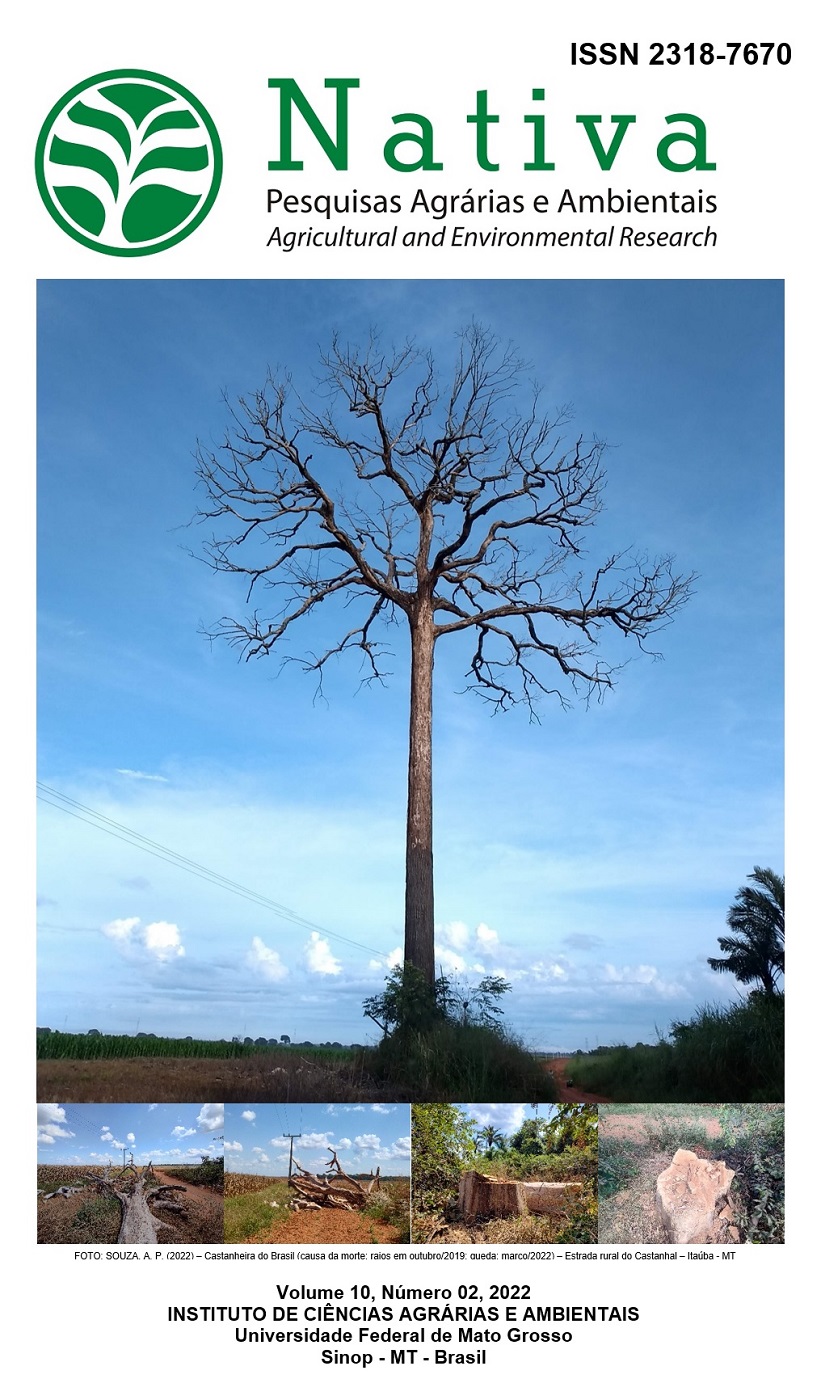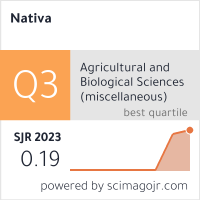EMERGÊNCIA DE BROTAÇÕES E RAÍZES DE ESPÉCIES SUCULENTAS EM FUNÇÃO DA APLICAÇÃO DE FERTILIZANTE ENRAIZADOR, EM AMBIENTES CONTRASTANTES
DOI:
https://doi.org/10.31413/nativa.v10i2.13184Palavras-chave:
Echeveria elegans, Graptosedum Francesco Baldi, Propagação, Sedum adolphiiResumo
O cultivo de plantas suculentas se popularizou no Brasil, aumentando a necessidade da compreensão do comportamento das espécies sob condições diferentes de produção. Assim, objetiva-se com este trabalho avaliar a influência de fertilizante enraizador, temperatura e luminosidade na emergência de brotações e raízes para espécies suculentas. Três experimentos foram conduzidos de novembro 2020 a fevereiro 2021, em casa de vegetação, com delineamento inteiramente casualizado, com quatro repetições, cada estudo com uma espécie: Echeveria elegans, Graptosedum Francesco Baldi e Sedum adolphii. Para cada espécie, os tratamentos foram arranjados em esquema fatorial (3x2), o fator A comparou fertilizante enraizador comercial e duas testemunhas (água e controle); e o fator B, as estacas foliares das espécies foram submetidas a dois ambientes de temperatura e luminosidade (24,8 oC e 449,8 µmol/m2s; 5 oC e 0 µmol/m2s). Avaliou-se aos 30 dias de instalação dos estudos: índice de velocidade de brotação; porcentagem de brotação; comprimento médio das raízes; comprimento médio do broto e massa seca total. O fertilizante beneficia a emissão de brotações e raízes na Echeveria elegans, porém tais efeitos não são verificados na ausência de luminosidade e baixa temperatura (5 oC). Esse ambiente também prejudicou as demais espécies avaliadas.
Palavras-chave: Echeveria elegans; Graptosedum Francesco Baldi; Propagação; Sedum adolphii.
Emergency of sprouts and roots of suculent species due to the application of rooting fertilizer, in contrasting environments
ABSTRACT: The cultivation of succulent plants became popular in Brazil, increasing the need to understand the behavior of species under different conditions. Thus, the aim of this work is to evaluate the influence of plant rooting fertilizer, temperature, and light intensity on the emergence of new shoots and roots for succulent species. Three experiments were conducted from November 2020 to February 2021, in greenhouse, with completely randomized design, with four replications, each study with one species: Echeveria elegans, Graptosedum Francesco Baldi and Sedum adolphii. The treatments for each species were arranged in factorial scheme (3x2), factor A compared commercial plant fertilizer and two checks (water and control); and factor B, the leaf cuttings of the species were submitted to two environments in relation to temperature and light (24.8 oC and 449.8 µmol/m2s; 5 oC and 0 µmol/m2s). It was evaluated at 30 days of installation: sprouting speed index; sprouting percentage; average root length; average sprout length and total dry mass. The fertilizer benefits the emission of shoots and roots in Echeveria elegans, but such effects are not observed for absence of light and low temperature (5 oC). This environment also harmed the other species evaluated.
Keywords: Echeveria elegans; Graptosedum Francesco Baldi; Propagation; Sedum adolphii.
Referências
ANH, J. H.; LEE, S. Y. Effect of growth regulators on callus induction and plant regeneration from leaf explants of Sedum sarmentosum. Korean Journal of Plant Biotechnology, v. 31, n. 1, p. 25-29, 2004. DOI: 10.5010/jpb.2004.31.1.025
CABAHUG, R. A.; SOH, S. Y.; NAM, S. Y. Effects of auxin and cytokinin application on leaf cutting propagation in Echeveria species. Flower Research Journal, v. 24, n. 4, p. 264-273, 2016. DOI: 10.11623/frj.2016.24.4.04
CABAHUG, R. A. M.; SOH, S. Y.; NAM, S. Y. Effects of shading on the growth, development, and anthocyanin content of Echeveria agavoides and E. marcus. Flower Research Journal, v. 25, n. 4, p. 270-277, 2017. DOI: 10.11623/frj.2017.25.4.12
CARRASCOSA, J. S.; GIANINI, P. F.; PEDROSO-DE-MORAES, C. Utilização de ácido 3-indolil-butírico no enraizamento de estacas foliares de rosa-de-pedra (Echeveria elegans ROSE). Revista em Agronegócio e Meio Ambiente, v. 9, n. 1, p. 135-145, 2016. DOI: 10.17765/2176-9168.2016v9n1p135-145
CAVALCANTE, A. B. C.; MENEZES, M. O. T.; MACHADO, M. C. Cactos do semiárido do Brasil: guia ilustrado. Campina Grande: INSA, 2013. 102p.
CHEN, Y. M.; HUANG, J. Z.; HOU, T. W.; PAN, I. C. Effects of light intensity and plant growth regulators on callus proliferation and shoot regeneration in the ornamental succulent Haworthia. Botanical Studies, v. 60, n. 10, 2019. DOI: 10.1186/s40529-019-0257-y
COLOMBO, R. C.; CRUZ, M. A.; CARVALHO, D. U.; HOSHINO, R. T.; ALVES, G. A. C.; FARIA, R. T. Adenium obesum as a new potted flower: growth management. Ornamental horticulture, v. 24, n. 3, p. 197-205, 2018. DOI: 10.14295/oh.v24i3.1226
FONSECA, E. F.; SILVA, G. O.; TERRA, D. L. C. V.; SOUZA, P. B. Uso potencial da casca de arroz carbonizada na composição de substratos para produção de mudas de Anadenanthera peregrina (L) Speg. Revista Desafios, v. 4, n. 4, p. 32-40, 2017. DOI: 10.20873/uft.2359-3652.2017v4n4p32
GRIFFITHS, H.; MALES, J. Succulent plants. Current Biology, v. 27, n. 17, p. 853-909, 2017. DOI: 10.1016/j.cub.2017.03.021
GRIMALDI, F.; GROHSKOPF, M. A.; MUNIZ, A. W.; GUIDOLIN, A. F. Enraizamento in vitro de frutíferas da família Rosaceae. Revista de Ciências Agroveterinárias, v. 7, n. 2, p. 160-168, 2008.
IBRAFLOR_Instituto Brasileiro de Floricultura. Disponível em: <https://www.ibraflor.com.br/numeros-setor> Acesso em: 20 out 2020.
KIM, H. J.; KIM, Y. J. Effect of shading degree and rooting media on growth of cuttings in Caragana sinica (Buc’hoz) Rehder and Sedum middendorffianum Maxim. Korean Journal of Medicinal Crop Science, v. 23, n. 4, p. 271-276, 2015. DOI: 10.7783/kjmcs.2015.23.4.271
KUROMORI, T.; SEO, M.; SHINOZAKI, K. ABA transport and plant water stress responses. Trends in Plant Science, v. 23, n. 6, p. 513-522, 2018. DOI: 10.1016/j.tplants.2018.04.001
LI, S.; LI, X.; WEI, Z.; LIU, F. ABA-mediated modulation of elevated CO2 on stomatal response to drought. Current Opinion in Plant Biology, v. 56, p. 174-180, 2020. DOI: 10.1016/j.pbi.2019.12.002
LORENZI, H. Plantas ornamentais do Brasil: arbustivas, herbáceas e trepadeiras. 4 ed. Nova Odessa: Instituto Plantarum, 2008. 1088p.
LORENZI, H.; OLSTHOORN, G.; COSTA, C. Cactos e outras suculentas para decoração. 1 ed. Nova Odessa: Instituto Plantarum, 2019. 400p.
NAM, S. Y.; LEE, H. S.; SOH, S.; CABAHUG, R. A. M. Effects of supplementary lighting intensity and duration on hydroponically grown Crassulaceae species. Flower Research Journal, v. 24, n. 1, p. 1-9, 2016. DOI: 10.11623/frj.2016.24.1.1
NEILL, E. M.; BYRD, M. C. R.; BILLMAN, T.; BRANDIZZI, F.; STAPLETON, A. E. Plant growth regulators interact with elevated temperature to alter heat stress signaling via the Unfolded Protein Response in maize. Scientific Reports, v. 9, n. 10392, p. 1-10, 2019. DOI: 10.1038/s41598-019-46839-9
PEREIRA, L.; MORRISON, L.; SHUKLA, P. S.; CRITCHLEY, A. T. A concise review of the brown macroalga Ascophyllum nodosum (Linnaeus) Le Jolis. Journal of Applied Phycology, v. 32, p. 3561-3584, 2020. DOI: 10.1007/s10811-020-02246-6
SAEGER, J. D.; VAN PRAET, S.; VEREECKE, D.; PARK, J.; JACQUES, S. Toward the molecular understanding of the action mechanism of Ascophyllum nodosum extracts on plants. Journal of Applied Phycology, v. 32, n. 1, p. 573-597, 2020. DOI: 10.1007/s10811-019-01903-9
SANTOS, J. L. C.; BRITO, E. L.; SOUSA, A. V. A. R.; SARAIVA, J. F. C. S.; DINIZ, F. O. Avaliação de enraizador comercial em diferentes tipos de estacas de rosa do deserto. In: ANDRADE, D.F. (ed.). Tópicos em Ciências Agrárias – Volume 5. 1 ed. Belo Horizonte: Poisson, 2020. p. 45-53. DOI: 10.36229/978-65-86127-17-1. (cap. 05)
SARADADEVI, R.; PALTA, J. A.; SIDDIQUE, K. H. M. ABA-Mediated stomatal response in regulating water use during the development of terminal drought in wheat. Frontiers in Plant Science, v. 8, n. 1251, 2017. DOI: 10.3389/fpls.2017.01251
SHUKLA, P. S.; MARTIN, E. G.; ADIL, M.; BAJPAI, S.; CRITCHLEY, A. T.; PRITHIVIRAJ, B. Ascophyllum nodosum-Based Biostimulants: Sustainable applications in agriculture for the stimulation of plant growth, stress tolerance, and disease management. Frontiers in Plant Science, v. 10, n. 655, p. 1-22, 2019. DOI: 10.3389/fpls.2019.00655
STULZER, G. C. G.; PAULA, J. C. B.; ROSOLEN, I. B.; PELLIZZARO, V.; TAKAHASHI, L. S. A.; FARIA, R. T.; KOYAMA, R. Enraizamento de estacas foliares de Sedum rubrotinctum (Crassulaceae) submetidas a métodos de aplicação de ácido indol-butírico (AIB) em diferentes concentrações. Terra e Cultura, v. 34, n. esp., p. 212-222, 2018.
TAIZ, L.; ZEIGER, E.; MOLLER, I. M.; MURPHY, A. Fisiologia e Desenvolvimento Vegetal. 6 ed. Porto Alegre: Artmed, 2017. 888p.
TAMAKI, T.; KUBO, S.; SHIMOMURA, K.; UMEHARA, M. Effects of gibberellin and abscisic acid on asexual reproduction from Graptopetalum paraguayense leaves. Journal of Plant Growth Regulation, v. 39, p. 1373-1380, 2020. DOI: 10.1007/s00344-020-10068-6
ZHU, Z. B.; YANG, J. F.; GUO, Q. S.; LIU, F.; WANG, R.; ZHANG, W-X. Effects of light intensity on growth, quality and antioxidant activities of Sedum sarmentosum. Zhongguo Zhong Yao Za Zhi, v. 43, n. 22, p. 4404-4409, 2018. DOI: 10.19540/j.cnki.cjcmm.20180820.008
Publicado
Versões
- 2023-10-06 (2)
- 2022-06-03 (1)
Edição
Seção
Como Citar
Licença
Copyright (c) 2022 Nativa

Este trabalho está licenciado sob uma licença Creative Commons Attribution-NonCommercial 4.0 International License.
Direitos Autorais para artigos publicados nesta revista são do autor, com direitos de primeira publicação para a revista. Em virtude de a aparecerem nesta revista de acesso público, os artigos são de uso gratuito, com atribuições próprias, em aplicações educacionais e não-comerciais.
A artigos publicados nessa revista, podem ser reproduzidos parcialmente ou utilizados como referência por outros autores, desde que seja cita a fonte, ou seja, a Revista Nativa.
Copyright for articles published in this journal are the authors, with first publication rights granted to the journal. The journal shows open access, and articles are free to use, with proper attribution, in educational and non-commercial.
The articles published in this journal may be reproduced in part or used as a reference by other authors, provided that the source is quoted.






